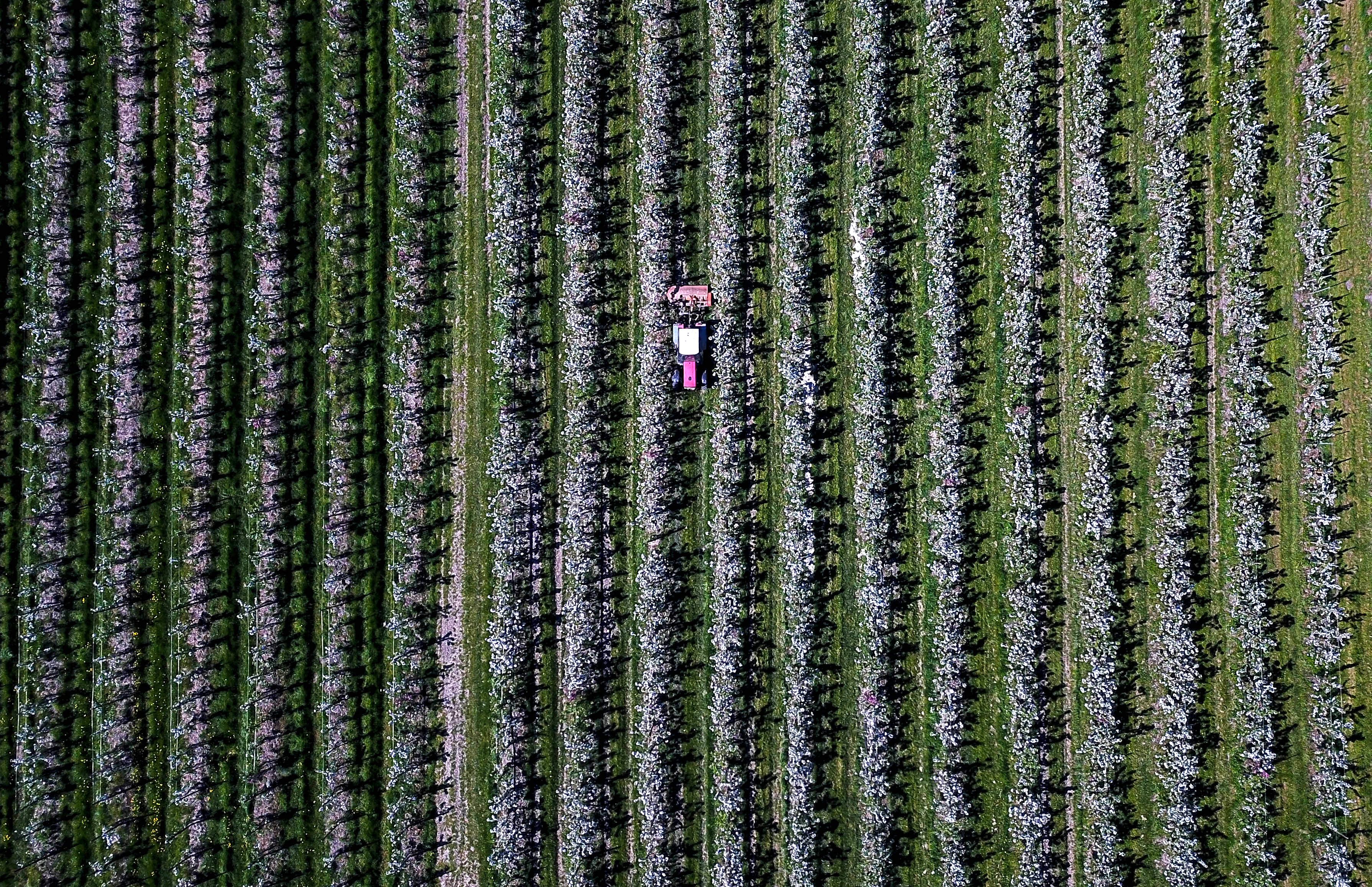A Systems Approach to Global Agriculture Could Solve Food Insecurity

A tractor drives through an apple orchard. There are many challenges facing the global agricultural value chain in terms of achieving nutrition security.
Photo: Axel Heimken / AFP/ Getty Images
When we look across the spectrum of challenges facing humanity, as well as at some of the largest potential commercial opportunities, we need not look any further than the dining table.
Meeting the nutritional needs of a growing population that is on pace to reach 10 billion by 2050 will not be easy.
Nutrition Security, Not Food Security
Fragility of supply chains, emerging diseases, weather disruptions, contagion risk, lack of water — these are only a handful of the many challenges facing the global agricultural value chain and food security.
To address these issues, the dialogue around food security in the 21st century will need to embrace a systems approach to agriculture that incorporates individual agents, as well as all the interactions within the system toward a holistic concept of nutrition security, not food security.
Over the last two decades, I’ve worked closely with just about every sector across the agricultural value chain: suppliers, producers, traders, consumer goods corps, co-ops, distributors, breeders, chemical manufacturers and many others. It is hard to think of another sector that reaches across as many subsectors as the food and beverage complex.
Large-scale centralized agriculture, which leads to regional monoculture, simply does not work over time. As my former Mars colleague Howard Shapiro has shown over the years, many of the calories that feed the world today are simply empty: calories with no nutritional benefit. Diminishing crop biodiversity accelerates agricultural disease, depletion of soil nutrients and productivity capacity, stress on water tables (particularly where deep-rooted varieties are dominant) and systemic crop risk, as well as the inhibition of food choices.
Decentralization Is Essential
A more decentralized approach toward the agriculture value chain will help ensure that the supply meets growing demand requirements, while encouraging equitable participation among suppliers, regardless of geography.
A systems approach will not only promote agricultural biodiversity and market participation, but will also enhance nutritional — and quite possibly societal — security. The global agriculture industry needs to adopt a decentralized approach built upon a systems foundation to evolve and meet societal needs in the coming decades.
Technology Only Gets You So Far
In recent years, the food industry has seen a rise in technology companies that look to the laboratory for new ways to feed the planet while minimizing environmental impact.
To take one example, synthetic biology has made great progress in R&D, potentially bringing to market commercially viable substitute protein products that satisfy the demands of the carnivore, without the ethical, environmental and economic issues commonly associated with traditional livestock production.
Another example with a potential upside can be seen in the burgeoning indoor or controlled-environment agriculture sector. Here we have also seen a rise in supply-side activity, both in the traditional startup community, as well as in the corporate venture space.
These and the many other “alternative agriculture” tools and technologies are certainly welcome pieces to the puzzle and will have a growing place in the portfolio of tools needed to address the industry’s decentralization.
However, at least in the short term, in aggregate, the suite of new market entrants still occupies a niche with respect to the global industrial agriculture stage.
When we analyze global agriculture, we can do so in the same manner that the biologist examines the behavior of the cell.
One Way Out: Physical Resource Theory
As a result of the complex nature of global food, the application of Physical Resource Theory (PRT) as a means to assess what can be grown, at what rates, under what environmental conditions and, above all, with commercially and socioeconomically equitable outcomes is an appropriate platform on which to build a tangible transition to Food 2.0.
PRT takes the engineer’s “first principles” approach to food, assessing the conversion of biological and physical resources into products.
Taking this one step further, PRT extends the analysis and understanding of the role of food products into the broader economic setting: the global food and beverage commercial value chain. The focus on the system of interactions, as opposed to solely emphasizing maximizing output from the individual components, leads to a more robust and adaptable system when disruptions arise.
The biophysics and economics of resource production cannot be divorced from one another. A complex systems/PRT framework more effectively weaves together considerations related to crop potential and market potential and will lead to more robust planning and sustainable solutions.
The Analogy of a Cell
When we analyze global agriculture, we can do so in the same manner that the biologist examines the behavior of the cell. In a cell, there is a collection of processes dealing with energetics, transfer, competition and cooperation, each agent performing a function that spills over and affects its neighbor.
Somehow all of this machinery comes together to result in a functioning cell embedded within a larger operating system. So by definition, the cell as a whole is more than the sum of its parts, and the emergent behaviors that have evolved allow the larger-scale systems to perform efficiently.
Taking the industrial biological metaphor from micro to macro, the same concepts can be constructed into a model that can guide the evolution of systematic benefits to global agriculture.
Competition is, of course, encouraged, but this can and should be balanced with cooperation incentives as a means to “open-source” benefits to the larger system. We have seen this approach work in software, genomics, computational and data sciences, and it is starting to take hold in energy and transportation. Agriculture should be next.
Diversity Builds Strength
Driven by economics, the waste from one industry becomes the feedstock for another. Diversity leads to not only system strength, but also system resilience. This interplay among agents actually becomes an indirect form of systemic risk management in the face of disruptions where the catalyst could be climate, disease, geopolitics, sanctions or any number of other external forces.
To be clear, all of this already occurs to some degree, but a more comprehensive and concentrated effort among market agents is needed for systemic PRT to scale.
So here are the takeaways going forward.
From the buyer’s perspective, decentralizing supply-side origins help to spread the risk and minimize raw material constraints in the event of disruption due to external forces, including climate, exchange rates and tariffs.
Given that threats to future supply continuity will increase due to weather changes, origin expansion will lead to a more resilient and flexible supply chain to meet growing demand.
Finally, viewing market expectations through a systems lens will allow for a better understanding of how the many facets of the global agricultural economy spill into other sectors. Any risk management approaches need to take account of these interdependencies, regardless of operating sector.
The favorable transition from physical/biophysical/economic theory to practice will result in a higher quality of life for consumers (nutrition security), sustainable business models for market agents (commercial security) and biosystem resilience and productivity (natural security).






